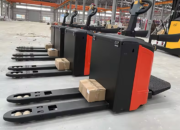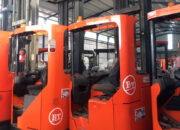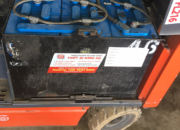Regulations on safe use of forklifts
When using a forklift, safety is always a top priority. Here are some basic safety rules when using a forklift:
– Training and certifications: Ensure forklift drivers have been properly trained and have the appropriate certifications in the use of forklifts.
– Test before use: Before operating, check the forklift to make sure it is working properly, check the mechanical, electrical system, hydraulic system, and other functional parts.
– Load: Do not exceed the load capacity of the forklift. Ensure even distribution of the load on the forks and do not raise it too high above the recommended load.
– Do not transport people: Forklifts are intended for the transport of goods only. No people are allowed on the fork or anywhere on the forklift.
– Safe operation: Drive the forklift at a slow speed, maintain a safe distance from objects or other people, and pay attention when moving in tight spaces.
– Emergency response: Train staff in emergency safety procedures, such as the emergency stop button and how to safely exit the forklift if needed.
Routine maintenance: Perform routine maintenance to ensure forklifts are always in good working condition.
– Apply guard posts: When the forklift is parked, use guard posts to prevent others from accessing and prevent the forklift from crashing.
Traffic Safety: Follow all traffic rules and safety instructions when using forklifts.
Environmental considerations: Avoid using forklifts in hazardous environmental conditions, such as heavy rain, wet floors, greasy floors, or poorly lit working conditions.
Remember, safety regulations may vary by location and type of forklift used. Therefore, be sure to follow all local regulations and manufacturer’s instructions when using a forklift.
Safety measures when using electric forklifts
When using an electric forklift, you need to follow some safety measures to ensure the safety of yourself and those around you. Here are some basic measures:
– Training and certifications: Ensure forklift operators have been properly trained and have the appropriate certifications in the use of electric forklifts.
Pre-Use Check: Before each shift, inspect the electric forklift to ensure that all systems are in good working order, including the electrical system, hydraulic system, brake system and wheels. .
– Load: Do not exceed the load capacity of the electric forklift. Ensure even distribution of the load on the forks and do not raise it too high above the recommended load.
– Apply guard posts: When not in use, park the forklift in safe places and use guard posts to prevent others from accessing and avoid collisions with the forklift.
– Traffic safety: Always obey traffic rules when moving electric forklifts, pay attention to speed limits and maintain a safe distance from objects or other people.
– Avoid lifting too high: Do not lift items too high for the job, as this can increase the risk of tipping over.
– Use anti-roll lever: When lifting, always use anti-roll lever to avoid rolling over when heavy objects are raised.
Electrical Protection: Avoid wetting the forklift’s pedals, levers or electrical components to avoid the risk of reduced performance or electrical hazards.
– Environmental considerations: Avoid using electric forklifts in hazardous environmental conditions, such as heavy rain, slippery or poorly lit working conditions.
– Power off when not in use: When not in use, always turn off the power of the forklift and set the anti-roll lever down to avoid unwanted accidents.
Safety measures when using diesel forklifts
When using a diesel forklift, the following safety measures should be followed to ensure the safety of yourself and those around you:
– Training and certifications: Ensure forklift drivers have been properly trained and have the appropriate certification in the use of diesel forklifts.
Pre-Use Inspection: Before each shift, inspect the diesel forklift to make sure all systems are working properly, including the electrical system, hydraulic system, brake system, and fuel system. Whether.
– Load: Do not exceed the load capacity of diesel forklift. Ensure even distribution of the load on the forks and do not raise it too high above the recommended load.
– Safety when lifting: When lifting, use anti-roll boom and make sure the item is firmly fixed on the fork to prevent falling.
– Traffic safety: Always follow traffic rules and safety instructions when moving diesel forklifts, keep a safe distance and pay attention to your surroundings.
– Explosion protection: Since diesel engines produce exhaust fumes and fire hazards, always check that the work environment is ventilated and limit exposure to fire or heat sources near the forklift area.
– Ear protection: Since diesel engines make high noise, make sure drivers and personnel in the area use ear protection or crash pads to protect their ears from noise.
– Eye protection: When performing lifting tasks or moving goods, use goggles to protect eyes from dust, oil







